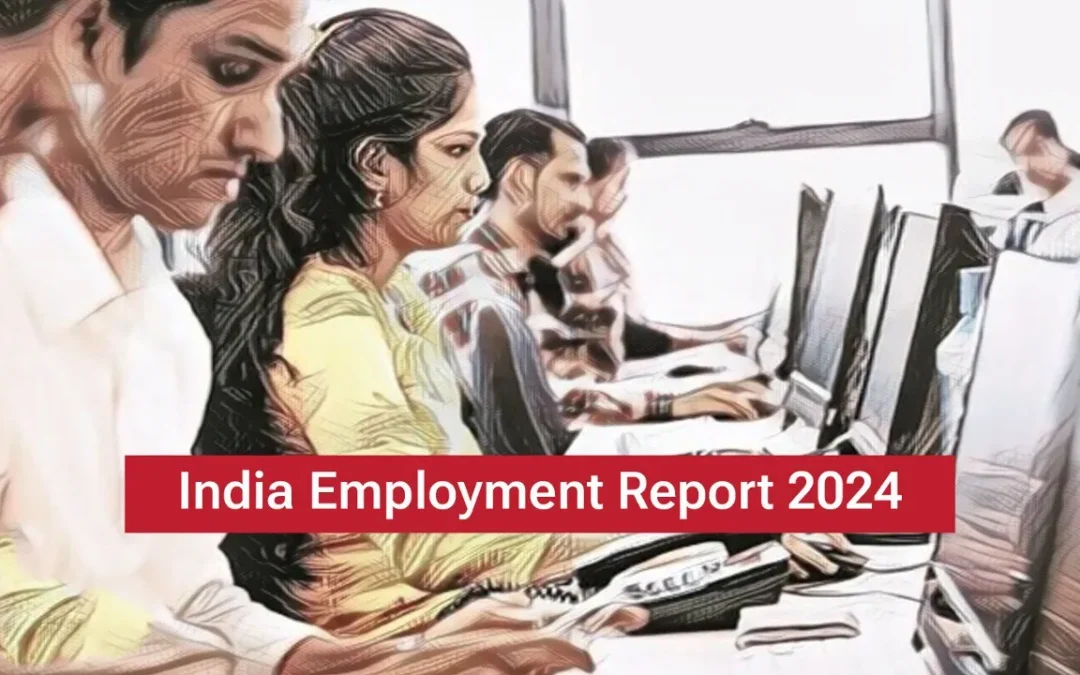India Employment Report 2024
Increasing Unemployment Among Educated Youth:
• Share of unemployed youth with secondary or higher education nearly doubled from 35.2% in 2000 to 65.7% in 2022.
• Youth account for almost 83% of the country’s unemployed workforce.
Trends in Employment and Underemployment
• Employment and underemployment increased between 2000 and 2019 but declined during the pandemic years.
• Educated youth experienced higher unemployment levels during this period.
Labour Market Indicators:
• Long-term deterioration in Labour Force Participation Rate (LFPR), Worker Population Ratio (WPR), and Unemployment Rate (UR) until 2018, followed by improvement after 2019.
• Improvement coincides with periods of economic distress, raising questions about the drivers of these changes.
Employment Trends Over Two Decades:
• Insufficient growth in non-farm sectors remains a challenge.
• Majority of workers engaged in informal work, with a decline in the share of regular work after 2018.
• Labour from agriculture absorbed by construction and services sectors.
Livelihood Insecurities and Social Protection:
• Widespread livelihood insecurities with limited coverage of social protection measures, particularly in the non- agriculture, organised sector.
• Rise in contractualisation and decline in coverage of regular workers by long-term contracts.
Skills Gap Among Youth:
• Significant gap in skills among youth, with many unable to perform basic tasks such as sending emails with attachments or using spreadsheets.
• Lack of quality employment opportunities leading to high joblessness among educated youth.
Gender Gap and Social Inequalities:
• Low rates of female labour force participation contributing to gender gap in the labour market.
• Despite affirmative action and targeted policies, Scheduled Castes and Scheduled Tribes lag in access to better jobs, reflecting growing social inequalities.
India’s Application to Explore the Afanasy Nikitin Seamount
India’s Application to ISBA:
• India applied to the International Seabed Authority (ISBA) for rights to explore two vast tracts in the Indian Ocean seabed.
• One of the regions, the Afanasy Nikitin Seamount (AN Seamount), is rich in cobalt and other minerals.
• Sri Lanka has also claimed rights to the region under separate laws.
Motivation Behind India’s Application:
• India’s application is partly motivated by reports of Chinese vessels undertaking reconnaissance in the same region.
• The AN Seamount is located about 3,000 km off India’s coast in the Central Indian Basin.
Exploration and Extraction Process:
• Interested explorers must apply for an exploration license to the ISBA for areas that are part of the open ocean.
• Around 60% of the world’s seas are open ocean, rich in mineral wealth, but extraction costs are prohibitive.
• Currently, no country has commercially extracted resources from open oceans.
UNCLOS Regulations:
• The Commission on the Limits of the Continental Shelf decides on the limits of a country’s continental shelf.
• Countries have exclusive rights up to 200 nautical miles from their borders, but some may extend their claims with scientific rationale.
Sri Lanka’s Claim and India’s Response:
• Sri Lanka has claimed up to 500 nautical miles under a provision allowing different criteria for claims along the Bay of Bengal.
• India has staked a claim for exploration due to observed Chinese presence, aiming to safeguard its interests in the region.
Challenges Faced by Indian Students in Socio-Academic Environment
Rising Student Suicides:
• Socio-economic changes have led to increased stress among Indian youth, resulting in tragic suicides.
• Kota, a hub for coaching institutes, witnesses a high number of student suicides due to academic pressure, with measures taken to prevent them.
Education System Challenges:
• Intense competition due to limited job opportunities and high fees in private institutions creates immense pressure on students.
• Lack of understanding from parents about their child’s wishes exacerbates the problem.
Education Sector Dynamics:
• Majority of colleges are under private administration, causing financial constraints for middle and lower-income families.
• Students face pressure to succeed in exams, leading to tragic outcomes when they fail.
Societal and Family Expectations:
• Weakening family structures and parental imposition of academic preferences impact students’ mental health.
• Students struggle to meet parental standards, leading to feelings of humiliation and desperation.
Need for Supportive Environment:
• Urgent need for a supportive social infrastructure to address the emotional needs of young students.
• Educational institutions fail to provide emotional support, exacerbating students’ mental health issues.
Challenges in Indian Municipal Elections
Delay in Holding Elections:
• Many municipalities fail to hold timely elections, violating constitutional mandates.
• Reports show significant delays in constituting elected councils across various states, with some cities waiting for years.
Delay in Constituting Councils:
• Even after elections, there are delays in forming councils and electing mayors, deputy mayors, and standing committees.
• Instances in Karnataka highlight significant delays in forming councils and conducting elections for leadership positions.
Need for Judicial Intervention:
• The Supreme Court’s intervention is necessary to enforce timely elections, as mandated by the Constitution.
• Despite court rulings emphasizing the inviolable nature of constitutional mandates, state governments continue to delay municipal elections.
Challenges in Election Processes:
• Issues include discretionary powers of government officials, potential state influence on election scheduling, and conflicts of interest in appointing presiding officers.
• Manual ballot paper-based processes also pose challenges to ensuring free and fair elections.
Role of State Election Commissions (SECs):
• SECs should play a more significant role in municipal elections, as mandated by the Constitution.
• While most states have SECs, only a few empower them to conduct ward delimitation, highlighting the need for their strengthened authority.
Potential Solutions:
• There is a need to standardize mayoral terms to five years to reduce the frequency of elections.
• Evaluating a role for SECs in conducting elections for mayors and standing committees could improve transparency and accountability in the process.
• Judicial intervention may be necessary to ensure the prioritization of municipal elections and strengthen the role of SECs, given the reluctance of state governments

